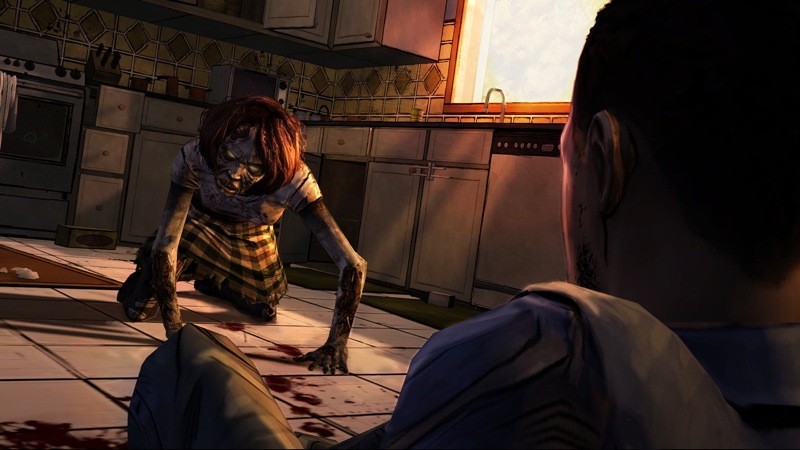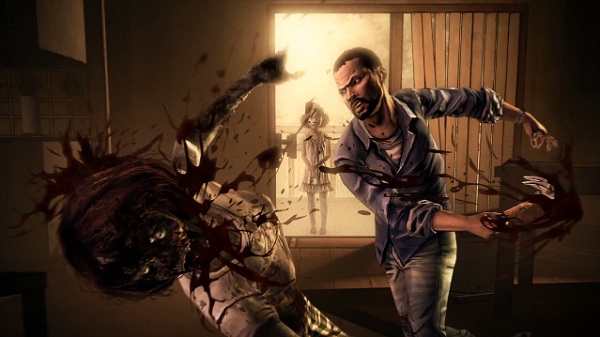Quick Search
Navigation
Featured Articles
- The Monsters of the Wailing Prison
- Strider Review
- BioShock Dev Irrational Fires All But 15 Employees
- New Titanfall Maps Confirmed
- There Are Aliens In Titanfall
- Guide: How to Dominate The Elder Scrolls Online PvP
- The Elder Scrolls Online PvP Experience
- Get Glow-in-the-Dark Condoms For Pre-Ordering InFamous: Second Son
- Batman: Arkham Origins Devs Have No Intention To Fix Bugs - Working On DLC Instead
- 8 Exclusive ESO Screenshots
The Walking Dead: Episode One Review
- 4-29-2012
- Categorized in: Reviews

Telltale has been cranking out adventure games like nobody’s business over the last few years, beginning with a revival of the Sam and Max series and culminating in tons of licensed fare. Despite the numerous games and myriad licenses being thrown around in the Telltale studios, their games have begun to take on a decidedly familiar approach. The different licenses for each new series have started to feel more like flavors of the week, with the core gameplay remaining more or less the same. Last year’s Jurassic Park marked Telltale’s first attempt at shaking up their core formula, and to be frank, it was disastrous. With that failed experiment under their belt, it may have been safest for the studio to go back to rehashing the same formula for their next product, The Walking Dead. Luckily, although this latest adventure does share many similarities with Telltale’s past work, it also (somewhat ironically, given its name) breathes new life into the tried and true adventure game formula thanks to a few important tweaks.

The most significant addition is the inclusion of direct character control. In Telltale’s past work, you would control your avatar by clicking the areas onscreen that you wanted your character to investigate. While you’ll still be doing plenty of pointing and clicking, there are certain sections where you will have to use the W/S/A/D keys (or the left stick, if you’re playing on console) to move your character around the environment. These sections don’t come up too frequently, and often when they do they are highly contextual. One might have you crawling desperately away from a hungry zombie, while another will see you rushing between cover points in hopes of avoiding a group of enemies. The direct control, coupled with the highly contextual basis on which it is implemented, serves to reinforce a notion of oneness between you and your avatar.
That avatar’s name is Lee, and his story is an intriguing and emotional one. I won’t get into the specifics of the tale, as experiencing the story is one of the best reasons to dive into the game, but the circumstances in which Lee begins the story raise several pressing questions, the answers to which will drive you forward throughout the game. It’s a solid mystery to build the game on, and its juxtaposition against the zombie apocalypse only serves to make it all the more intriguing. There are a few moments of ham-fisted dialogue, but for the most part the script makes the most of the setting and characters, and delivers on the premise better than I could have asked for.

Atmosphere is a large part of what makes The Walking Dead work as well as it does. One of my biggest worries coming into this game was that the writing and production teams at Telltale just wouldn’t be able to handle the task of crafting a serious drama, experienced as they are with comedy and slapstick. Thankfully, that wasn’t an issue at all. During my three hours with Episode One, I could hardly bring myself to turn away from the screen. The story crackles with suspense, and most of the characters are relatable and well-written. It’s almost impossible to resist the urge to jump right back in after you beat the game once, too, thanks to a wide range of branching paths and alternate dialogue options. Your choices seem to have a real effect on the direction that future episodes will take, if the post-episode stinger is anything to go by.
The great comic book art style serves to reinforce the suspense, in its own unique way. To put it simply, Telltale’s current engine just isn’t capable of producing facial expressions and body animations detailed enough to do justice to the gravity of the situations that unfold over the course of the game. The heavily stylized artwork of The Walking Dead makes this a non-issue by grouping this piece of fiction closer to the comic books, rather than the TV show. It’s harder to notice the lack of detail in the animations and expressions when the whole world looks like a comic book panel. That said, the graphics are still detailed enough that the gore, when it comes, is appropriately repellant and satisfying. This intelligent decision marks the first of many when it comes to the visual experience of The Walking Dead.

During gameplay, all of the items that you can interact with will be marked by a white circle. This eliminates any need to pixel hunt around the various environments looking for every last interactive item. It also serves to make puzzle solving more about figuring out how to intelligently use your surroundings, rather than trying to figure out which key items you may not have found yet. Although the zombie-infested world of The Walking Dead doesn’t lend itself especially well to a lot of puzzles, a few are sprinkled here and there to break up the action. Most of them revolve around ways to distract zombies so that your group may pass safely. None of the puzzles lean too heavily on “adventure game logic,” (you know, the logic that dictates a jar of maple syrup combined with cat fur creating a mustache) instead relying on real-world concepts and physics, only stretched just a bit to fit within the context of the game. These puzzles will make you feel clever without demanding too much.
All is not perfect in the world of The Walking Dead, though. Aside from the hoards of shambling undead, a host of technical issues bog down the otherwise gripping story. During my playthroughs, I experienced several instances of heavy slowdown. One instance, which occurred at the exact same moment when I played through for a second time, was so cripplingly slow that the game began to run like a slideshow. A friend of mine played through this exact same section with no issues, though, so perhaps it depends on which components have been stuffed into your PC. It’s still a problem worth noting, though, as my PC can play graphically intensive games such as The Witcher 2 and Battlefield 3 on the highest settings with no problem, so it must be an issue inherent to the game.

Other technical issues serve to further pronounce the line between game and reality. Loads can be frequent in some areas, and they’ll often come suddenly, with no warning. They can be jarring, and happen all too often. Then there are the glitches. At one point in the story, I got stuck in an infinitely-looping conversation and had to restart in order to escape. At a few other points, my clicks failed to register the first or even second time that I tried to interact with the environment.
The Walking Dead has its issues, but they are mostly of a technical nature and aren’t so extreme as to mar the entire experience. With a great art style, an intense and horrifying story, and choices that feel like they really matter, this adventure game makes all of the changes and tweaks that I’ve been wishing for from the genre. It feels like a step forward not just for Telltale, but for the genre as well, albeit a small and safe one.
Score: 8.5/10





Hey!
I heard each episode comes out once a month. I wish each one were a bit longer but I enjoy the game and the t.v show is my fave can't wait till Oct.21 of this year :)
Is the new episode, 2 coming out? and I wanna know once you pay 400 microsoft points to download the game, it says you have to download each episode.. do I have to pay more? I hope not as I feel it's not worth it because their not long enough.
If someone can answer my questions: when does the new xbox360 episode come out for the walking dead and do I have to pay more points to download the other episodes? shouldnt have to but I just wanna know as I haven't heard from anyone else about it.
Episode part 2 should come out sometime this June. Yes you do have to pay for each episode. They are not going to let you buy the whole game for 5 dollars